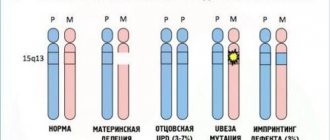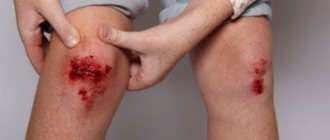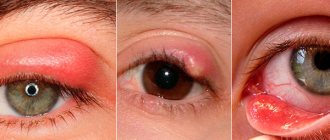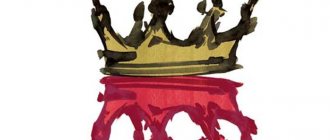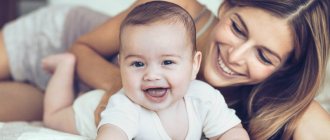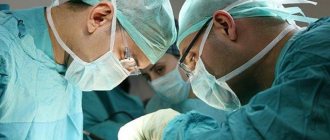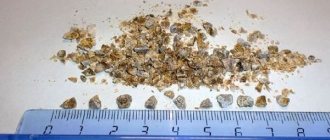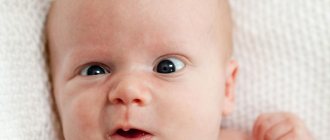Autism - what kind of disease is it? Causes of autism, symptoms and early signs
Autism in children is a special personality disorder, which, although characterized by a violation of social behavior and adaptation to environmental conditions, is not a disease.
The syndrome develops in the first years of a child’s life, when there is an absence or inadequate reaction to auditory or visual stimuli, strange fears, and repetitive behavior. If similar symptoms are observed in a teenager, this diagnosis is doubtful.
The level of intellectual development in this disease can be very different: from profound mental retardation to giftedness in certain areas of knowledge and art; In some cases, children with autism have no speech, and there are deviations in the development of motor skills, attention, perception, emotional and other areas of the psyche. More than 80% of children with autism are disabled.
Causes of autism
Most often, children with RDA are physically absolutely healthy; they do not show any visible external defects. In mothers, pregnancy proceeds without any special features. In sick babies, the structure of the brain is practically no different from the norm. Many even notice the special attractiveness of the facial part of an autistic child.
However, in some cases, other signs of the disease still appear:
- maternal infection with rubella during pregnancy;
- chromosomal abnormalities;
- tuberous sclerosis;
- cerebral palsy;
- violation of fat metabolism - obese women have a high risk of giving birth to a child with congenital autism.
All of the above conditions have a negative impact on the child’s brain and can lead to the development of autism. According to research, genetic predisposition plays a role: if there is an autistic person in the family, the risk of developing the disease increases. However, reliable reasons have not yet been identified.
Symptoms of autism in a child
In some children, symptoms of autism can be detected as early as infancy. Autism most often appears by age three. Signs of autism may vary depending on the child's developmental level and age (see photo).
Behavioral characteristics used to describe autism syndrome:
The development of non-speech and speech communication is impaired. Characteristic:
- Speech is normal, but the child cannot talk with others;
- The speech is abnormal in content and form, that is, the child repeats phrases heard somewhere that do not apply to the given situation;
- Lack of facial expressions and gestures. Speech may also be absent;
- The child never smiles at the interlocutor, does not look him in the eyes;
- Speech is phonetically abnormal (problems with intonation, rhythm, monotony of speech).
The development of imagination is impaired, which leads to a limited range of interests. Characteristic:
- Preference is given to solitude, playing with oneself;
- Lack of imagination and interest in imaginary events;
- gravitates toward a certain object and experiences an obsessive desire to constantly hold it in his hands;
- Unnatural, nervous, aloof behavior;
- An autistic child exhibits tantrums when the environment changes;
- Experiences a requirement to repeat the same actions exactly;
- Concentrates his attention on one thing.
The development of social skills is impaired. Characteristic:
- Ignoring the feelings and existence of other people (even parents);
- They don’t share their problems with loved ones because they don’t see the need for it;
- Children do not want to communicate and make friends with their peers;
- They never imitate the facial expressions or gestures of other people or repeat these actions unconsciously, without connecting them in any way with the situation.
People with autism are characterized by uneven development, which gives them the opportunity to be talented in some narrow area (music, mathematics). Autism is characterized by impaired development of social, thinking, and speech skills.
Symptoms of Autism
Signs of autism in children under 1 year of age
At this age, it is necessary to pay attention to whether the child’s development corresponds to the main stages. Here are a few things to worry about:
- Shows no interest in persons.
- Doesn't look into your eyes, doesn't smile, and it may seem like your baby is looking right through you.
- Doesn't always respond to sounds.
- Doesn't respond to his name, turn to see where the sound is coming from, or show any activity when he hears a loud noise. In other situations, his hearing may seem excellent.
- Doesn't like being hugged or touched.
- Shows no interest in typical children's games.
- Does not babble or show other early signs of talking.
- Does not use gestures as a way of communication.
Signs of autism in children under 2 years of age
Among the most common:
- Doesn't use gestures.
- Doesn't shake his head: yes or no.
- Doesn't indicate what he wants.
- Does not point out objects to show interest in the world around them. By 14 to 16 months, most healthy children will direct your attention to something they are interested in, such as a puppy or a new toy.
- Does not use single words at 16 months or two-word phrases at 24 months.
- Lost verbal or social skills. Used a few words to talk or showed interest in people, but no longer does so.
- Problems with walking.
Signs of ASD in 3-year-old children
Some children develop symptoms of autism in the first few months of life. Others do not show symptoms for up to two years. Mild signs are difficult to detect and may be mistaken for a shy temperament or personality trait.
You may see some of the signs of autism in three-year-old children.
Communication skills:
- does not respond to name;
- avoids eye contact;
- prefers to play alone;
- does not like or avoids physical contact with other people;
- not interested or doesn't know how to make friends;
- has difficulty expressing or talking about feelings and has difficulty understanding others' feelings.
Language and communication skills:
- speech and language skills are delayed (lags behind peers);
- echo conversation - repeating the last few words of a conversation.
Behavioral skills:
- performs repetitive movements;
- toys or other objects are arranged in an organized manner;
- do not like changes in everyday life;
- cyclical repetitions of game movements;
- frequent observation of fire, water and spinning wheels.
Other potential signs of autism:
- impulsiveness;
- aggressive behavior;
- severe tantrums;
- picky eating;
- lack of feeling of fear.
Having any of these signs or symptoms may be normal, but having more than one of them, especially with a speech delay, should be of additional concern.
What are the signs of autism in a 4 year old child?
Signs of autism in children become more obvious as they age.
Your child may show some of the following signs of autism.
Communication skills:
- does not respond to his name;
- avoids eye contact;
- prefers to play alone than to play with others;
- doesn't tell stories;
- not interested in interacting or communicating with others;
- dislikes or actively avoids physical contact;
- grimaces;
- has difficulty understanding other people's feelings and does not express his own well.
Language and communication skills:
- cannot create sentences;
- repeats words or phrases over and over;
- does not answer questions appropriately or follow directions;
- does not understand counting or time;
- changes pronouns (for example, says “you” instead of “I”);
- rarely or never uses gestures or body language such as waving.
Behavioral disorders:
- performs repetitive movements;
- builds toys or other objects in a certain sequence;
- gets upset by small changes in daily life;
- plays with toys the same way every time;
- loves certain parts of objects (often wheels);
- has obsessive interests;
- repeats certain procedures cyclically.
Additional signs of autism in 4 year olds:
- hyperactivity or short attention span;
- impulsiveness;
- aggression;
- hysterics;
- irregular reactions to sounds, smells, tastes, sights, or textures;
- inappropriate emotional reactions.
Signs of autism in children 5 years old
Social Communication Red Flags:
- the child does not share observations or experiences with others;
- generally does not look directly at other people (sometimes called lack of eye contact);
- there may be a lack of speech or unusual speech patterns such as repetition of words and phrases (echolalia), refusal to use “I”, substituting “you” and “you”;
- may be reluctant to be hugged, prefers to be around familiar people, and may seem to treat people as objects and a source of comfort;
- avoids social situations, preferring to be alone;
- there is limited development of play activities, in particular creative play;
- increased tearfulness or unusual lack of crying.
Behavioral red flags:
- frequent, repetitive movements such as shaking or flapping hands, prolonged rocking or spinning of objects;
- having an obsessive interest in certain toys or objects while ignoring other things;
- being extremely resilient to changes in procedures or their environment;
- Difficulty eating – cannot chew hard objects;
- Difficulties often arise with potty training;
- sleep problems;
- irritation or aggression when visiting crowded and noisy places.
Signs of autism at age 6
The signs of autism from 6 to 15 years of age are similar, and in the absence of full correction, they can worsen every year.
Social/emotional problems:
- difficulty creating and maintaining friendships;
- isolated or repetitive play;
- atypical interests compared to peers;
- disobedient or unaware of how his actions affect others;
- expresses severe anxiety, depression, anger, or fear.
Speech skills:
- monotone or unusually formal speech;
- literal interpretation of phrases, does not understand sarcasm or jokes;
- low/poor nonverbal communication skills;
- may shut down and not respond to requests or questions.
Behavioral skills:
- increased interest/hyperfocus on one specific topic, interest, or object;
- intense reaction to changes in everyday routine;
- cyclic hand movements, rocking, or other gestures when upset or excited;
- excessive reactions to touch, textures, pain, or sounds;
- poor motor and coordination skills;
- anxiety, depression, selective silence.
Autism in a child over 11 years old
Simple communication skills have been mastered, but the child prefers to spend time in a deserted room. Other signs are also noted:
- interest is directed only to one area, a toy, a cartoon, a program;
- attention deficit;
- aimless complex movements;
- compliance with one’s own, often ridiculous from the outside, rules;
- strange fears also occur;
- hyperactivity;
- the need for a uniform arrangement of furniture and things in the house - if it is moved, the child may have a hysteria or panic attack;
- the child must follow a certain sequence when dressing, waking up, and going to bed;
- self-directed aggression.
Teaching children with autism is difficult, but this does not mean that all autistic people have a low IQ - it is difficult for them to quickly change their activity and focus their attention equally on several objects. Parenting requires enormous effort on the part of parents: after all, if a child has learned to go to the potty or change clothes at home, this does not mean that he will be able to do this at a party or in kindergarten.
The first signs of autism in a child: when do they appear?
A parent will notice the first signs of autism in a child at about 2-3 years of age. However, if you are careful, you can recognize them even in infants.
How does autism manifest in infants?
- the baby does not show animation and interest when parents appear in his field of vision;
- does not maintain eye contact with the person who is trying to communicate with him;
- the child does not smile;
- the baby either does not react at all to external stimuli (touch, light, noise), or shows too strong a reaction.
These early signs are not clear indicators of autism syndrome: they may, for example, indicate problems with hearing or vision in the child.
Therefore, symptoms of autism in children can be suspected only when their manifestations are pronounced. They can be detected first by parents who have already observed similar disorders in their older children or in one of their relatives. But young mothers and fathers who have never encountered manifestations of autism in children, as a rule, do not pay attention to deviations in the child’s development, considering them “character features.” Therefore, diagnosis of the syndrome in such families is often delayed. Autism in children is usually diagnosed at the age of 3 years. It is at this time that the symptoms of the disorder increase; they are easier to notice when the child begins to attend various clubs, sections or kindergarten. Indeed, against the background of the development of other children, the signs of autism become obvious. But even if the child does not attend any development groups, the parents of a three-year-old child themselves pay attention to the child’s lack of many skills.
In general, autism in children manifests itself as developmental disorders. However, if you begin to correct these disorders at an early age, then many of the child’s skills and abilities can be developed. This means that the baby will be better adapted to society, will be able to lead a normal life and communicate with peers. In order to recognize developmental problems in a child as early as possible, experts suggest that all parents of one-year-old babies objectively answer some questions on the test for autism in children.
How to determine autism in a child yourself
You can assume that your child has signs of autism if you answered no to all questions on the test:
- Does your baby want to be petted or cuddled by his parents when he's upset, crying, or getting ready to sleep?
- Does your child ask to be held, does he want to sit on your lap while reading a book, watching a cartoon, or just like that?
- Does the child show interest in other children?
- Does the child play role-playing or object games: mother-daughter games (feeding the doll, putting it to bed, preparing food), car races, soldier battles, etc.?
- Does your child like to play with adults?
- Does the child point at objects and people, trying to formulate a phrase?
- Does the child maintain eye contact when communicating?
- If you name an object or pet and point at it with your finger, does the child look for it with his eyes?
If parents answered no to many of these questions, this may be a reason to contact a psychotherapist or psychiatrist.
Scientists from the Russian autism research laboratory at the Moscow State Psychological and Pedagogical University have developed a test for autism in children. The technique, in their opinion, makes it possible to detect manifestations of autism in children aged 3-4 months. No special equipment is required to carry out the test: all you need is a regular computer, on the screen of which lines are depicted in a special way. The child looks at the lines, and the computer program records his orientation sensitivity - a special property of human perception that manifests itself already in infancy.
Among the forms of autism in children, experts distinguish early (when signs of the syndrome appear before two years of age), as well as disorders of childhood (from 2 to 11 years) and adolescence (from 11 to 18).
Symptoms of the disease between the ages of 2 and 11 years
Children with autism at this age still experience symptoms that were relevant for the previous period. The child does not respond to his own name, does not look him in the eye, likes to be alone, and has no interest in other children. In addition, other characteristic symptoms of the disease are noted:
- Perhaps, again, repetition of the same type of actions (peculiar rituals), when changing his usual environment, he becomes very anxious.
- The child knows only a few words and may not speak at all.
- The child may constantly repeat the same word; he does not maintain a conversation.
- For the most part, children with autism struggle to acquire skills that are new to them; at school age they lack the ability to read or write.
Some children develop an interest in a certain type of activity, for example, mathematics, music, drawing, etc.
What should parents be wary of in the behavior of a child under two years of age?
It is believed that autism can be suspected if a child:
- does not maintain eye-to-eye contact for any length of time;
- does not respond to a name with intact hearing;
- exhibits a deficit of joint attention (that is, does not try to attract the attention of others to the subject that interests him with a word or gesture);
- does not ask for help;
- does not try to share anything;
- uses another person as if they were an inanimate object.
If these signs constantly appear in the child’s behavior, then you should definitely contact a child psychiatrist. Diagnosing childhood autism is difficult. Even an experienced specialist needs a lot of time to observe and analyze the picture of this mental disorder. You should be calm about scheduling repeat appointments, examinations and consultations. Some signs of autism are found in profound and severe mental retardation and severe speech underdevelopment. Therefore, without a sufficient understanding of the nature of the violations, treatment and correctional work may not be effective enough.
Signs of early childhood autism under 2 years of age
In most cases, manifestations of the disease are observed in children during the first year of their life. There may be characteristic differences in the behavior of a sick child from the behavior of peers. The following symptoms are also noted:
- The child rarely smiles;
- There is no attachment to the mother. So, the child does not cry like other children when she goes somewhere, he does not smile at her and does not reach out for her arms;
- A child with autism does not look at the parents’ face, into their eyes;
- The child may have an inadequate response to stimuli that are insignificant for others (light, muffled sounds, etc.), in addition, he may experience fear because of them.
- The child is noted to be aggressive towards other children, he does not strive to communicate with them and to play together;
- A sick child gives preference to only one toy (or a separate part of it) in play; there is no interest in other toys;
- There is a delay in speech development. So, by 12 months the child does not babble, does not use the simplest words by the age of 16 months, and by the age of 24 months does not reproduce simple phrases.
Meanwhile, it is important to note that such symptoms are not at all exclusive indicators of the relevance of autism, although they require some concern. Therefore, the child’s avoidance of society, his silence, self-absorption - all these manifestations must be discussed with the pediatrician.
Autism in children: symptoms, signs and treatment
Autism
– a disease associated with a violation of a person’s social adaptation, speech function, and mental development. When autism is diagnosed early in children, treatment can have noticeable results, and the main focus of therapy is the education and socialization of the child. The situation with the recognition and treatment of autism in Russia is not simple; timely diagnosis and correction of autism becomes primarily the task of parents.
Back in the middle of the last century, autism was a fairly rare disease. But over time, more and more children are identified who suffer from it. In Russia, there are no official data on the number of autistic children: such a count is not kept. By rough standards, there are tens of thousands of “rain children” in our country and we differ little from America.
The rise in cases of autism in children is a matter of serious concern, but has not yet been motivated. Scientists only agree that autism is provoked by a complex of factors, and not by one single cause.
Possible triggers for autism include:
· gene modifications;
Organic lesions of the central nervous system (encephalitis, abnormal development of parts of the brain);
· hormonal imbalances, metabolic disorders;
· exposure to viral and bacterial infections;
· excessive use of antibiotics;
· chemical effects on the mother’s body during pregnancy.
Whether these factors can actually cause autism in children has not been fully identified. But it is clear that with a hereditary predisposition to this disease, any serious impact on the child can lead to autism, including severe fright or infection.
Signs and symptoms of autism in children
In order to recognize autism in a child in time, you need to carefully observe his behavior and record manifestations that are atypical for children of the same age. Of course, this task faces primarily parents.
In a broad sense, autism is a group of diseases that share some common symptoms (autism spectrum disorders). They are especially obvious when the child reaches the age of one and a half to two years. Here they are:
· Speech impairment.
Some autistic children do not speak at all, others are far behind their peers in speech development. Children under the age of 12 months do not walk, can make the same sounds, at 2 years they have an extremely poor vocabulary (about 15 words), by 3 years they are almost unable to combine words. But autistic children can repeat words and phrases heard somewhere like an echo, invent their own words (neologisms), while many do not use speech to communicate. Autistic people talk about themselves in the third person and do not use addresses or personal pronouns.
· Lack of emotional contact with people, primarily with parents.
Children with autism do not look people in the eye, do not reach out to their parents, or smile. Autistic people often resist their parents' attempts to pick them up and caress them. In their behavior, such children are similar to those who are deaf or blind: they do not distinguish their parents from other people, and do not notice that someone is addressing them.
· Problems in socialization.
Being among others, a child with autism experiences severe discomfort and, over the years, anxiety. "Children of the rain" can run and hide if someone actively contacts them. They do not know how to play with peers, they cannot build friendly relationships, because they do not understand the emotions of other people, the rules of games. Autistic people prefer solitude, which protects them from strong feelings about their inability to communicate.
· Attacks of aggression.
Any frustration or failure can cause a child to have an outburst of anger, provoke hysteria, or a physical attack. Aggression in autistic children can be directed at others and at themselves, the latter was recorded in 30% of patients.
· Weak interest in toys.
A child with autism does not know how to play with different objects, cars, dolls. Such children are usually not capable of symbolic actions, that is, they cannot depict some objects with the help of others due to poorly developed abstract thinking. For example, if a mother asks her to make tea in a toy bowl, the child will not stir an empty cup with a spoon or will not be able to replace the spoon with a chopstick; he can only repeat someone else’s actions, seen and heard. A manifestation of autism in children is also the non-standard use of toys: for example, a child does not roll a car, but spins its wheel for hours. Another option is a commitment to only one toy or part of it, to the same small objects.
· Stereotypical behavior, fear of change.
Autistic children tend to do the same things over and over again: repeating the same word, running in circles, swaying from side to side, looking at rotating objects, twirling something, etc. They are characterized by compulsive behavior, that is, adherence to certain rules and routines. If this routine is violated, they become very worried, resist, and become aggressive. This reaction can happen either when moving to another apartment, or if someone rearranges the toys on the shelf.
Each case of the disease is individual: childhood autism may have all of the listed symptoms, or may manifest itself only in some features of behavior and speech. There are milder forms of the disease, in which the autistic person finishes school, works, and starts a family.
Diagnosis of autism in children
In order to suspect an autism spectrum disorder, a child must have three symptoms at the same time:
· difficulties in social interaction;
· communication disorders;
· repetitive, stereotypical behavior.
It is important to note that with childhood autism (classic), all these signs appear in the first three years of the child’s life.
In Russia, diagnosing childhood autism is difficult due to the lack of standards and appropriate training for medical personnel. A pediatrician is usually unable to suspect autism due to a child's atypical behavior, and parents rarely report such facts. Normally, if childhood autism is suspected, it is necessary to undergo a medical commission, which, in addition to the attending physician, should include a neurologist, psychiatrist, psychologist, preferably the presence of a specialist in autism spectrum diseases, as well as parents and educators (if the child attends kindergarten).
IQ level in autism
Most children with autism have mild or moderate mental retardation. It is associated with brain defects and learning difficulties. If the disease is combined with microcephaly, epilepsy and chromosomal abnormalities, then the level of intelligence corresponds to severe mental retardation. With mild forms of the disease and dynamic development of speech, intelligence can be normal or even above average.
The main feature of autism is selective intelligence. That is, children can be strong in mathematics, music, and drawing, but at the same time be far behind their peers in other respects. The phenomenon when an autistic person is extremely gifted in some area is called savantism. Savants can play a melody after hearing it just once. Or paint a picture seen once, accurate to halftones. Or keep columns of numbers in your head, performing complex computational operations without additional means.
Sleep disorders
Many children with autism experience sleep disturbances. Children may not distinguish between day and night, remain equally active at any time of the day, they may be difficult to put to sleep, and they may wake up frequently during the night. Sleep periods can be very short: one to two hours. Pain sensitivity in children with autism may be reduced and even absent, or, on the contrary, it may be excessively high. Children with autism also experience seizures. The likelihood of developing epilepsy as a concomitant disease increases with age.
Severity
There are several degrees of severity, which make it even more clear what autism is:
| 1st degree | Children can communicate, but in unusual surroundings they are easily lost. Movements are awkward and slow; the child does not gesture, his speech is amicable. Sometimes such children are diagnosed with mental retardation. |
| 2nd degree | Children do not appear withdrawn or aloof. They talk a lot, but do not address anyone. They especially love to talk about their area of interest, which they have studied thoroughly. |
| 3rd degree | In a familiar environment, the child behaves normally, but when visiting new places he has an attack of panic or self-injury. Such a patient confuses pronouns and answers with useless cliches. |
| 4th degree | Children do not respond to treatment, do not make eye contact, and practically do not speak. If they are comfortable, they sit for hours, looking ahead, discomfort manifests itself in screaming and crying. |
Signs and symptoms
Autism in children is a mysterious disease in which each patient has different symptoms. However, every patient with autism has common characteristics that give reason to believe that they have this disease. Signs and symptoms of childhood autism vary by age. Therefore, there are four main groups of signs and symptoms: early-onset autism (in children under two years of age), childhood autism (in children from two to eleven years of age), adolescent autism (in teenagers from eleven to eighteen years of age) and adult autism.
Age - from 2 to 11 years
Children over two years old still have all the symptoms that are characteristic of early autism (does not respond to their name, does not look into the eyes of their interlocutor, plays alone, etc.), and others also join them:
- The child does not want to take part in conversations, never starts a conversation and does not strive to communicate at all;
- The child is interested in only one type of activity (music, drawing, mathematics);
- Can repeat the same word or sound constantly;
- If there is a change in the usual environment, the child panics;
- The child has difficulty acquiring skills and cannot learn to read and write at school.
Age: over eleven years old
At this age, children with autism usually acquire basic social skills, but still prefer to be alone. Puberty in children with autism is much more difficult than in normal children. They become aggressive and may be depressed.
Diagnosis of autism
External clinical signs of autism in a child of the first year of life are practically absent, and only experienced parents with more than 1 child in the family manage to notice any developmental abnormalities with which they consult a doctor.
If there are already cases of autism in the family or lineage, then it is extremely important to carefully monitor the child and promptly seek medical help if necessary. The sooner a child is diagnosed, the easier it will be for him to adapt to the world and society around him.
The main methods for diagnosing autism in children are:
- examination of the child by an otolaryngologist and a hearing test - this is necessary to exclude delayed speech development due to hearing loss;
- EEG – carried out to detect epilepsy, since sometimes autism can manifest itself as epileptic seizures;
- Ultrasound of the brain - allows you to identify or exclude damage and abnormalities in the structure of the brain that can provoke symptoms of the disease;
- conducting tests with special questionnaires.
Parents themselves must correctly assess changes in the behavior of a child who may have autism.
Autism in children
Autism is currently a poorly understood disease. There are no methods for treating the disease, early diagnosis of autism, the causes and mechanism of its development are not localized and unknown. However, there are techniques that can correct and alleviate the course of autism.
Autism in children symptoms
- An autistic child shows detachment from the world around him, he is unable to form contacts with people and is very attached to his mother (parents).
- In autistic children, there is a delay or regression of mental and speech development, speech disorders, and the child does not use personal pronouns in speech.
- There is a violation of social adaptation, avoids contact with strangers, avoids visual and tactile contacts, prefers peripheral vision, prefers inanimate objects for games.
- Signs of autism in children include motor impairment and adherence to stereotypical activities.
- Weak ability to learn, lackluster interest in what is happening around, does not copy the behavior of others
- Reacts unpredictably to events, fear of bright external stimuli.
- Tendency to hysterics, aggression, self-injury.
Causes and mechanisms of development of autism in children
The causes and mechanisms of autistic manifestations have not been reliably identified. There is a modern classification of autism in children used by specialists (approved in 1997 by the Scientific Center for Mental Health of the Russian Academy of Sciences):
Childhood autism of internal origin.
Occurs without an external visible reason. This category includes:
- Kanner's syndrome.
- Infantile autism (“convenient child” aged 0 to 12-18 months).
- Childhood autism (previously classified as schizophrenia, but, unlike adults, the condition gradually improves with treatment).
- Asperger's syndrome (intelligence preserved, isolation noted, strange and florid speech, most often studying in secondary schools).
Organic autism.
The disease is caused by the presence of certain damage to the nervous system: hydrocephalus, hypoxia, birth trauma, etc. With timely treatment of the identified pathology, the patient’s condition improves.
Autistic-like syndromes
for chromosomal, metabolic and other disorders. The cause is considered to be diseases of the central nervous system (tuberculous sclerosis, phenylketonuria, etc.), genetic and chromosomal diseases (Down syndrome).
Rett syndrome
(unspecified origin).
Autistic-like syndromes of exogenous origin.
Psychogenic paraautism. Occurs under the influence of external causes: stress, orphanhood, condition after injury, etc.
Autism of unknown origin.
Diagnosis of autism is difficult and is carried out based on identified behavioral abnormalities. All types of autism in children and adults have the following in common:
1.
The activity of the frontal lobes of the brain, which are responsible for intelligence, consciousness, and initiative, decreases. This, in turn, entails the manifestation of the following signs of autism in children: decreased cognitive activity, interest in the environment, detachment. Such children are afraid of change and new surroundings. They don't accept new games etc.
2.
The frontal lobes do not send impulses to the rest of the brain centers (speech, motor, visual, etc.). As a result, actions become stereotypical and unconscious. Actions are not aimed at anything and can be repeated many times: tapping a hammer on the table, running in a circle, etc. This occurs because the frontal lobes do not direct attention to understanding the world around us.
3.
Since there is no control of the frontal lobes, all other areas of the brain are subsequently delayed in development and do not develop evenly. Complex and simple skills can be demonstrated simultaneously: phrases and babble in speech, primitive games and complex skills.
4.
Speech zones, like all others, do not develop, so the child does not understand spoken speech. He is not aware that he is being addressed, does not use his vocabulary, does not use speech to communicate and satisfy his needs.
5.
Auto-aggression arises as a protest against the surrounding reality. The child does not understand that one can protest with speech. He splashes out aggression on himself or others. If your head hurts, you hit yourself on it, or rub it, or press your hands. At the same time, he is capricious and crying.
6.
Emotional development is inhibited, the child cannot experience complex emotions - empathy, humor, care. Only simple emotions - fear, aggression.
All manifestations are associated with a failure of the frontal lobes of the brain and the coordinated work of various areas of the brain. In some cases of autism, children have obvious neurological pathology. Therefore, attention is directed to the treatment of identified neurotic pathology. Such pathologies include: hydrocephalus, manifestations of Down syndrome, cerebral palsy, etc. Regardless of the reason that led to asynchronous development of the brain, it is necessary to stimulate the activity of the frontal lobes and speech centers.
Diagnosis of autism in Chelyabinsk
Unfortunately, external signs of autism in children become obvious only closer to primary school age, when normally the child should master communication skills. Until then, parents attach little importance to the fact that their child can barely pronounce a few words, while his peers are busy constructing long sentences. Pediatricians also pay little attention to signs of autism in children during routine examinations. Silence and isolation are attributed to character traits, fueling the false illusion that over time the child will catch up with his peers. However, behind the external signs of autism in children there are organic brain lesions that do not allow speech skills and learning abilities to develop properly. If you do not provide professional medical assistance to an autistic child, it is impossible to count on his independent social adaptation. It is extremely important to have time to teach an autistic person basic communication skills in the preschool period. Failures at school will only increase the distance between the autistic person and his classmates, if studying in a mainstream school remains possible at all.
That is why parents should be more attentive to their child and seek advice from a neurologist for the first signs of autism in children.
There is no need to create panic out of nowhere. A sign alone cannot indicate a disease. A brain examination will finally help dispel doubts. The Indigo Children Research Institute presents a unique diagnosis of autism with evoked potentials. The method provides objective data not available in other studies. Already in the first months of life, it is possible to identify possible pathologies and predict further intellectual development.
Early diagnosis makes it easier to correct the manifestations of autism and quickly adapt the child to independent life.
Early childhood autism. Forecasts
With proper correctional work, it is possible for the child to adapt to the environment. There are several groups of early childhood autism.
Group 1:
The child is completely detached, there is no social activity, no reaction to a smile, glance, wet diapers, hunger. Such children have a hard time making eye contact and avoid physical contact.
Group 2:
Active rejection of the environment. The child carefully selects the types of contacts with the outside world, communicates with a limited circle of people, and is selective in clothing and food. Violation of the usual regime causes affective reactions: fear, aggression, auto-aggression. A large number of speech and motor stereotypes. Children with autism belonging to this group are more adapted for life than children from group 1.
Group 3:
Preoccupation with autistic interests. Children try to hide from the outside world in their own interests. The classes are stereotypical, not cognitive in nature, and cyclical. Conversations for years on the same topic, drawing or reproducing the same plot in games. Interests are often dark, frightening, and aggressive.
Group 4:
Extreme difficulty interacting with the environment. Mild manifestation of early childhood autism. Children have increased vulnerability and vulnerability. They are sensitive to other people’s assessments and avoid relationships if they feel some kind of obstacle.
Corrective work with a child is calculated in such a way as to consistently guide the child through the listed groups of social interaction.
Treatment of childhood autism is prescribed strictly individually.
At the Indigo Children Research Institute, we are sure that autism is not a death sentence. The success of autism treatment here is based on mastering the achievements of modern medicine and the coordinated work of many children's specialists. This is work that requires enormous patience and great love for your work. If you start it on time, the child will be able to go to a regular school.
Treatment of autism
The answer to the main question: is autism treatable? -No. There is no cure for this disease. There is no pill that, after drinking, will help an autistic child come out of his “shell” and become socialized. The only way to adapt an autistic person to life in society is through persistent daily practice and the creation of a favorable environment. This is a lot of work by parents and teachers, which almost always bears fruit.
Principles of raising an autistic child:
- Create a favorable environment for the child’s life, development and learning. A frightening environment and an unstable daily routine slow down an autistic person’s skills and force them to “withdraw” even deeper.
- Understand that autism is a way of being. A child with this condition sees, hears, thinks and feels differently from most people.
- Involve a psychologist, psychiatrist, speech therapist and other specialists in working with the child if necessary.
At the present stage, help for sick children can only be provided by a correctional program drawn up by a competent specialist - a sequence of actions that are carried out not to cure autism (it cannot be treated), but with the goal of maximizing the child’s adaptation to environmental conditions.
To implement this program, the help of parents is very important, because for the baby the whole world is incomprehensible and hostile.
Correction is carried out in special rehabilitation centers (for example, Our Sunny World or Childhood). The correction program depends on the form and severity of the disease. It includes:
- drug treatment;
- gluten-free diet;
- hippotherapy;
- behavioral therapy;
- music therapy;
- play therapy;
- exercise therapy;
- dolphin therapy;
- massage.
Classes of different types of therapy can be conducted in different centers. Thus, hippotherapy is usually carried out in a specially equipped arena, music treatment is carried out in special rooms. Physical therapy and massage are usually carried out in the same clinic.
What to do?
Yes, autism is a child development disorder that lasts throughout life. But thanks to timely diagnosis and early correctional assistance, much can be achieved: adapt the child to life in society; teach him to cope with his own fears; control emotions.
- The most important thing is not to disguise the diagnosis as supposedly “more harmonious” and “socially acceptable.” Do not run away from the problem and do not focus all your attention on the negative aspects of the diagnosis, such as disability, misunderstanding of others, conflicts in the family, etc. An exaggerated idea of a child as a genius is just as harmful as a depressed state from his failure.
- It is necessary without hesitation to abandon tormenting illusions and plans for life built in advance. Accept the child for who he really is. Act based on the child’s interests, creating an atmosphere of love and goodwill around him, organizing his world until he learns to do it on his own.
Remember that a child with autism cannot survive without your support.
Social interaction disorders
Impaired social interaction is the most important symptom of autism. Often a small child with autism behaves as if he is tuned in to his own wavelength; he may not show interest in the games of other children and even stubbornly refuse to participate in common games; it can be difficult to interest him in something that an adult offers him, he does not repeat the actions, movements and sounds of adults.
- The child may not notice whether parents are at home or at work, whether they have gone somewhere or returned home
- May become upset when an adult tries to join in his games
- Can sit alone in the crib and scream loudly, monotonously, instead of calling mom
- May not show interest in other children's games
- May not show interest in playing hide and seek and other games that involve interacting with other people
- It is often difficult to attract his attention to toys or books
- Doesn't smile back when you smile
- Doesn't respond to his name
- May clearly and desperately resist hugs, kisses and not allow himself to be picked up by either his parents or other people
Teaching an autistic child
An autistic child, as a rule, cannot study in a regular school. More often, homeschooling is done by parents or a visiting specialist. Special schools have been opened in large cities. Training there is carried out using special methods.
The most common training programs:
- “Time on the floor”: the technique suggests treatment and teaching communication skills to be carried out in a playful way (a parent or teacher plays with the child on the floor for several hours).
- “Applied Behavior Analysis”: step-by-step training under the guidance of a psychologist from simple skills to the formation of spoken language.
- The “More Than Words” program method teaches parents to understand the nonverbal way of communicating with a child using gestures, facial expressions, his gaze, etc. The psychologist (or parents) help the child develop new methods for communicating with other people that are more understandable to them.
- Card exchange teaching method: used for severe autism and when the child has no speech. During the learning process, the child is helped to remember the meaning of various cards and use them for communication. This allows the child to take initiative and facilitates communication.
- “Social stories” are original fairy tales written by teachers or parents. They should describe situations that cause the child’s fears and anxiety, and the thoughts and emotions of the characters in the stories suggest the child’s desired behavior in such a situation.
- The TEASSN program: the methodology recommends an individual approach to each child, taking into account his characteristics and learning goals. This technique can be combined with other teaching technologies.
A strict daily routine, constant and not always successful activities with a child suffering from autism leave an imprint on the life of the entire family. Such conditions require extraordinary patience and tolerance from family members. But only love and patience will help you achieve even the slightest progress.
Prognosis for autism
The number of British studies talking about qualitative changes and devoted to long-term prognosis is small. Some autistic people experience minor improvements in their communication skills as adults, but for many more these skills worsen.
The prognosis for the development of autism is as follows: 10% of adult patients have several friends and require some support; 19% have a relative degree of independence, but remain at home and require daily supervision, as well as significant support; 46% require specialist care for autism spectrum disorders; and 12% of patients require highly organized hospital care.
Swedish data from 2005 in a group of 78 autistic adults showed even worse results. Of the total, only 4% lived an independent life. Since the 1990s, as well as the early 2000s, the increase in reports of new cases of autism has increased significantly. Since 2011-2012, autism spectrum disorder has been observed in every 50th schoolchild in the United States, as well as in every 38th schoolchild in South Korea.

